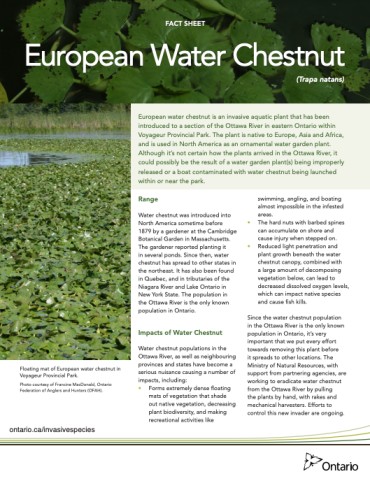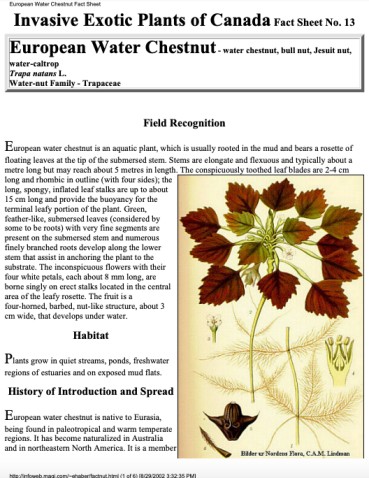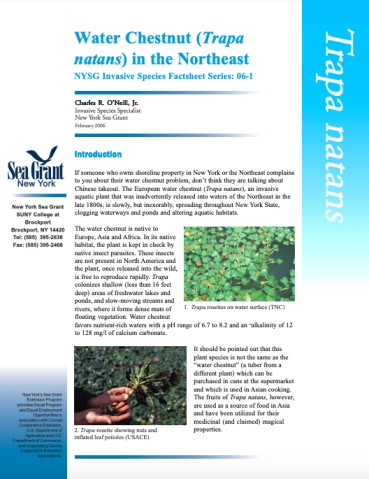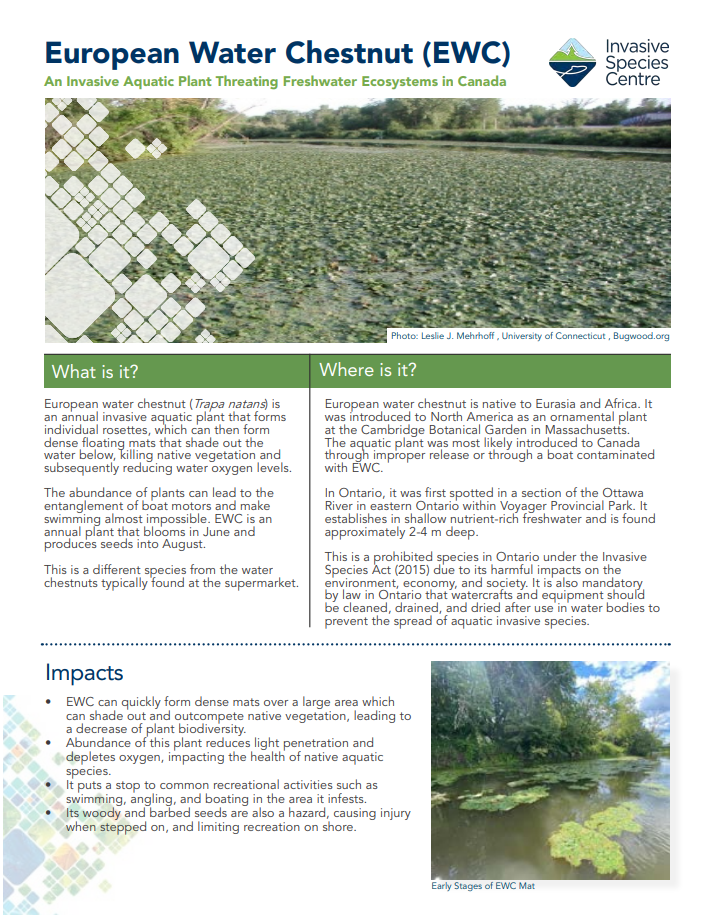European Water Chestnut (Trapa natans)
French common name: Châtaigne d'eau
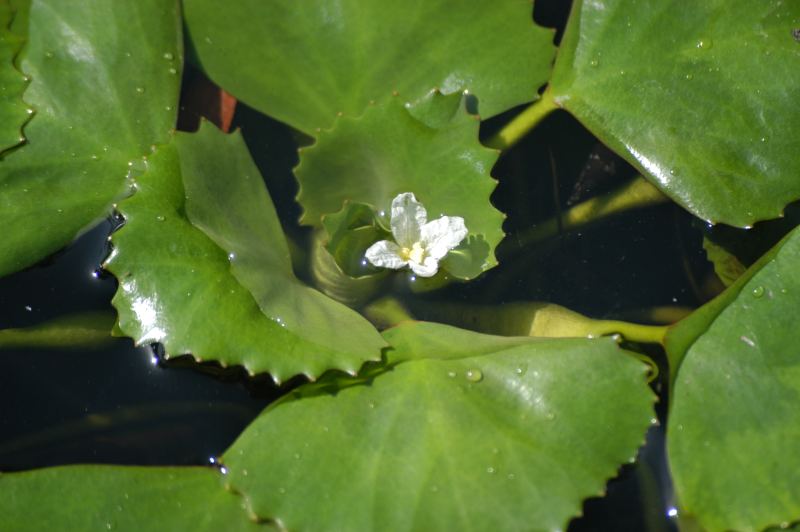
Water chestnut has small white flowers with four petals.
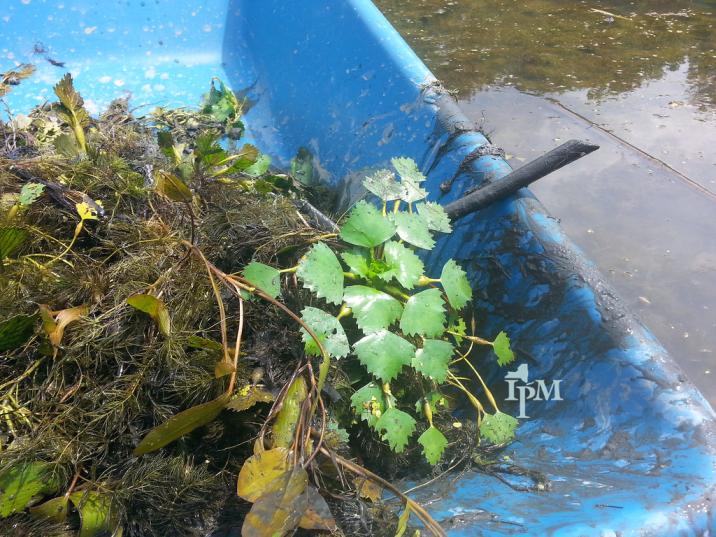
Water chestnut removal.
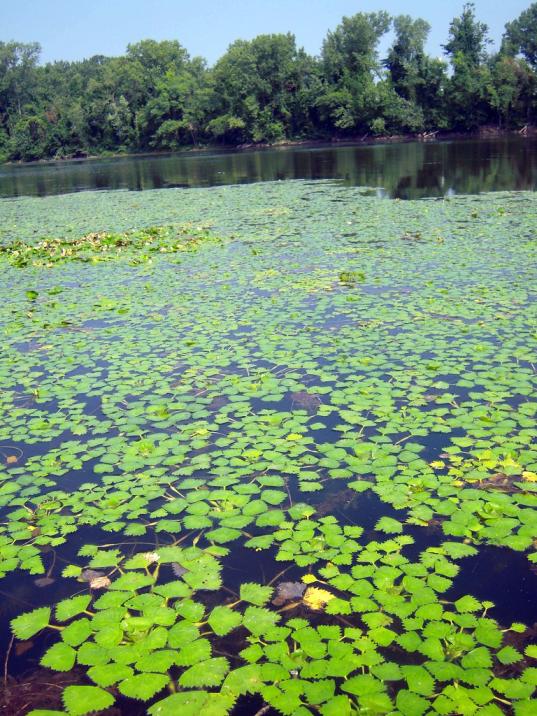
Water chestnut infestation.
Order: Myrtales
Family: Lythraceae
European water chestnut is an aquatic plant with a hard stem that can reach up to 3-5 m in height. The leaves sit above the water, spread out in a circular pattern, and are triangular with serrated edges. In June, European water chestnut blooms small white flowers with four petals. The dense floating leaves shade out the water below, killing native vegetation and subsequently reducing water oxygen levels. The plants also get tangled in boat motors and make swimming almost impossible. European water chestnut seeds are 3-4 cm wide and have sharp barbed spines which are very painful to step on, making swimming or walking in invaded areas dangerous. Water chestnut can thrive in lakes, rivers, streams, and ponds with soft substrate, full sun, and nutrient-rich waters. It is most abundant in water that is approximately 2 m deep but can be found in water up to 4 m deep.
European water chestnut is an aquatic perennial plant that grows in shallow or deep water. It can grow up to 3.5-4.5 m (12-15 ft) and form dense, floating mats.
Water chestnut has an appearance unlike any other plant species in Ontario. Features that can be used to identify water chestnut include:
- Floating leaves that are green with sharply toothed edges. The leaves form a densely crowded rosette up to 30 cm in diameter.
- Leaf stems up to 15 cm long, with a spongy swollen section that helps the plant float.
- Underwater leaves that are feather-like with finely dissected leaf segments.
- Small flowers (8 mm long) that are white and have four petals.
- Hard “woody” seeds, 3-4 cm wide with sharp barbed spines. Viable seeds are greenish brown and sink to the bottom. Older seeds are black, floating, and not viable.
- The nuts bear no resemblance to the “water chestnut” used in cooking.
Water chestnut was introduced into North America sometime before 1879 by a gardener at the Cambridge Botanical Garden in Massachusetts. The gardener reported planting it in several ponds. Since then, water chestnut has spread to other states in the northeast. It has also been found in Quebec and in tributaries of the Niagara River and Lake Ontario in New York State.
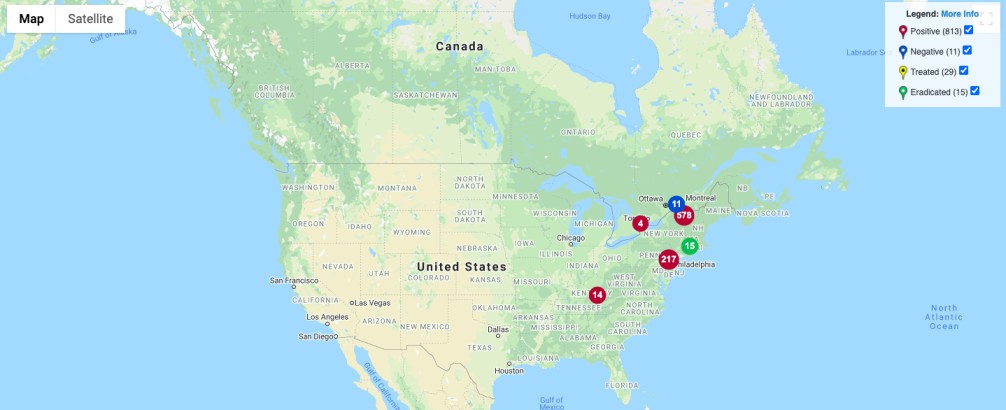 Water chestnut distribution via EDDMAPS
Water chestnut distribution via EDDMAPS
Water chestnut populations in the Ottawa River, as well as neighbouring provinces and states, have become a serious nuisance causing a number of impacts (Ontario, 2016):
- Forms extremely dense floating mats of vegetation that shade out native vegetation, decreasing plant biodiversity, and make recreational activities like swimming, angling, and boating almost impossible.
- The hard nuts with barbed spines can accumulate on shore and cause injury when stepped on.
- Reduced light penetration and plant growth beneath the water chestnut canopy, combined with a large amount of decomposing vegetation below, can lead to decreased dissolved oxygen levels, which can impact native species and cause fish kills.
Learn how to identify European water chestnut and prevent accidentally spreading the plants and seeds. This is especially important if you are planning to work or participate in recreational activities in areas that contain water chestnut (Ontario, 2016).
- Do not plant European water chestnut in your water garden. Water gardeners should use only native or non-invasive plants and are encouraged to ask garden centres for plants that are not invasive.
- Never release unwanted aquarium plants or pets into any waterbody. Return or donate unwanted plants or pets to a pet store or garden center, a school, or a friend.
- Always inspect your boat and boating equipment and remove any plants or animals that are visible before leaving the waterbody.
- To prevent spreading plants and seeds to new locations, avoid boating through the area around the Ottawa River that contains European water chestnut.
- Report sightings to the Invading Species Hotline 1-800-563-7711 or visit www.invadingspecies.com.
Fact Sheets
Research
Drying and rehydration characteristics of water chestnut (Trapa natans) as a function of drying air temperature
oven at different air temperatures (50, 60, 70, 80 and 90° C) to compare the drying rate and
to analyze the effect of different drying air temperature on rehydration properties. The …
Review of world literature on water chestnut with implications for management in North America
temperate and tropical freshwater wetlands, rivers, lakes, ponds, and estuaries. Native to
Eurasia and Africa, water chestnut has been widely gathered for its large nutritious seed …
Structure and Properties of Water Chestnut (Trapa natans L. var. bispinosa Makino) Starch
var. bispinosa Makino) starch showed that its pasting temperature was 71° C and its
viscosity was low (max, 310 BU) which remained constant during heating and increased …
CHARACTERISTICS OF STARCH FROM WATER CHESTNUT (TRAPA BISPINOSA ROXB.)
were investigated. Scanning electron microscopy of the starch granules showed that they
were either oval or round in shape with small horn (s) protruding from the surface. Amylose …
Further Reading
The Invasive Species Centre aims to connect stakeholders. The following information below link to resources that have been created by external organizations.

